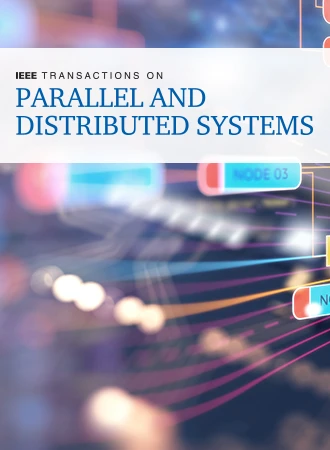WASP:高效电源管理,实现感知工作负载、自供电的人工智能物联网设备
IF 5.6
2区 计算机科学
Q1 COMPUTER SCIENCE, THEORY & METHODS
IEEE Transactions on Parallel and Distributed Systems
Pub Date : 2024-06-03
DOI:10.1109/TPDS.2024.3408167
引用次数: 0
摘要
边缘人工智能的广泛应用提高了对各种免电池和免维护智能系统的需求。然而,新兴的人工智能物联网(AIoT)是一种复杂的工作负载,显示出更高的功耗需求、多样化的用电模式以及对电源管理(PM)方法的独特敏感性。现有的人工智能物联网设备无法选择最合适的电源管理调节旋钮,因此常常做出次优决策。此外,这些电源管理解决方案总是假定采用传统的电源调节电路,这会产生不可忽略的功率损耗和控制开销。这会大大降低 AIoT 的潜在效率。在本文中,我们探讨了新兴自供电 AIoT 设备的电源管理(PM)优化。我们提出了 WASP,一种针对工作负载感知、自供电 AIoT 设备的高效电源管理方案。WASP 的新颖之处有两方面。首先,它将离线剖析和轻量级在线控制相结合,为给定的 DNN 模型选择最合适的 PM 调节旋钮。其次,它非常适合可重新配置的电压调节模块,能充分利用有限的功率预算。我们的研究结果表明,与其他现有方法相比,WASP 能让 AIoT 设备在严格的功率预算下多完成 65.6% 的推理任务,且性能不会下降。本文章由计算机程序翻译,如有差异,请以英文原文为准。
WASP: Efficient Power Management Enabling Workload-Aware, Self-Powered AIoT Devices
The wide adoption of edge AI has heightened the demand for various battery-less and maintenance-free smart systems. Nevertheless, emerging Artificial Intelligence of Things (AIoT) are complex workloads showing increased power demand, diversified power usage patterns, and unique sensitivity to power management (PM) approaches. Existing AIoT devices cannot select the most appropriate PM tuning knob, and therefore they often make sub-optimal decisions. In addition, these PM solutions always assume traditional power regulation circuit which incurs non-negligible power loss and control overhead. This can greatly compromise the potential of AIoT efficiency. In this paper, we explore power management (PM) optimization for emerging self-powered AIoT devices. We propose WASP, a highly efficient power management scheme for workload-aware, self-powered AIoT devices. The novelty of WASP is two fold. First, it combines offline profiling and light-weight online control to select the most appropriate PM tuning knobs for the given DNN models. Second, it is well tailored to a reconfigurable voltage regulation module that can make the best use of the limited power budget. Our results show that WASP allows AIoT devices to accomplish 65.6% more inference tasks under a stringent power budget without any performance degradation compared with other existing approaches.
求助全文
通过发布文献求助,成功后即可免费获取论文全文。
去求助
来源期刊

IEEE Transactions on Parallel and Distributed Systems
工程技术-工程:电子与电气
CiteScore
11.00
自引率
9.40%
发文量
281
审稿时长
5.6 months
期刊介绍:
IEEE Transactions on Parallel and Distributed Systems (TPDS) is published monthly. It publishes a range of papers, comments on previously published papers, and survey articles that deal with the parallel and distributed systems research areas of current importance to our readers. Particular areas of interest include, but are not limited to:
a) Parallel and distributed algorithms, focusing on topics such as: models of computation; numerical, combinatorial, and data-intensive parallel algorithms, scalability of algorithms and data structures for parallel and distributed systems, communication and synchronization protocols, network algorithms, scheduling, and load balancing.
b) Applications of parallel and distributed computing, including computational and data-enabled science and engineering, big data applications, parallel crowd sourcing, large-scale social network analysis, management of big data, cloud and grid computing, scientific and biomedical applications, mobile computing, and cyber-physical systems.
c) Parallel and distributed architectures, including architectures for instruction-level and thread-level parallelism; design, analysis, implementation, fault resilience and performance measurements of multiple-processor systems; multicore processors, heterogeneous many-core systems; petascale and exascale systems designs; novel big data architectures; special purpose architectures, including graphics processors, signal processors, network processors, media accelerators, and other special purpose processors and accelerators; impact of technology on architecture; network and interconnect architectures; parallel I/O and storage systems; architecture of the memory hierarchy; power-efficient and green computing architectures; dependable architectures; and performance modeling and evaluation.
d) Parallel and distributed software, including parallel and multicore programming languages and compilers, runtime systems, operating systems, Internet computing and web services, resource management including green computing, middleware for grids, clouds, and data centers, libraries, performance modeling and evaluation, parallel programming paradigms, and programming environments and tools.
 求助内容:
求助内容: 应助结果提醒方式:
应助结果提醒方式:


